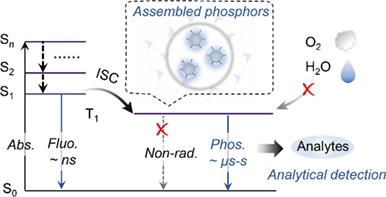当前位置:
X-MOL 学术
›
Chin. J. Chem.
›
论文详情
Our official English website, www.x-mol.net, welcomes your
feedback! (Note: you will need to create a separate account there.)
Aqueous Room-Temperature Phosphorescence from Assembled Phosphors for Analytical Detection†
Chinese Journal of Chemistry ( IF 5.5 ) Pub Date : 2022-12-05 , DOI: 10.1002/cjoc.202200672 Peisheng Cao 1 , Qian Chen 2 , Peng Wu 1, 2, 3
Chinese Journal of Chemistry ( IF 5.5 ) Pub Date : 2022-12-05 , DOI: 10.1002/cjoc.202200672 Peisheng Cao 1 , Qian Chen 2 , Peng Wu 1, 2, 3
Affiliation

|
Room-temperature phosphorescence (RTP) has gained much attention in organic light-emitting diodes (OLEDs), anti-counterfeiting, encryption and bioimaging. However, efficient RTP is typically difficult due to the spin-forbidden transition nature and susceptibility to environment quenching. In aqueous phase, such quenching is much more pronounced, leading to the collection of aqueous RTP even more challenging. Assembly systems (either organic or inorganic), provide an excellent microenvironment for accommodating of phosphors in aqueous phase, due to the excluding of typical phosphorescence quenchers (H2O and O2) and rigidification of phosphorescent molecules for inhibition of non-radiative transitions (molecular motions). Herein, we summarized the recent progress in harvesting RTP from aqueous systems via various assembling strategies, including small molecules, supramolecular inclusion, and inorganic assembly. More specifically, the analytical explorations of these systems were discussed, from the perspective of the relationship between analytes and phosphorescence. Last, the further developments of aqueous RTP analysis were also prospected. 
中文翻译:

用于分析检测的组装荧光粉的水性室温磷光†
室温磷光 (RTP) 在有机发光二极管 (OLED)、防伪、加密和生物成像等领域备受关注。然而,由于自旋禁止转变性质和对环境淬火的敏感性,有效的 RTP 通常很困难。在水相中,这种淬灭更为明显,导致水性 RTP 的收集更具挑战性。由于排除了典型的磷光猝灭剂(H 2 O 和 O 2) 和磷光分子的硬化以抑制非辐射跃迁(分子运动)。在此,我们总结了通过各种组装策略从水性系统中获取 RTP 的最新进展,包括小分子、超分子包合物和无机组装。更具体地说,从分析物和磷光之间的关系的角度讨论了这些系统的分析探索。最后,还展望了水溶液RTP分析的进一步发展。
更新日期:2022-12-05

中文翻译:

用于分析检测的组装荧光粉的水性室温磷光†
室温磷光 (RTP) 在有机发光二极管 (OLED)、防伪、加密和生物成像等领域备受关注。然而,由于自旋禁止转变性质和对环境淬火的敏感性,有效的 RTP 通常很困难。在水相中,这种淬灭更为明显,导致水性 RTP 的收集更具挑战性。由于排除了典型的磷光猝灭剂(H 2 O 和 O 2) 和磷光分子的硬化以抑制非辐射跃迁(分子运动)。在此,我们总结了通过各种组装策略从水性系统中获取 RTP 的最新进展,包括小分子、超分子包合物和无机组装。更具体地说,从分析物和磷光之间的关系的角度讨论了这些系统的分析探索。最后,还展望了水溶液RTP分析的进一步发展。



















































 京公网安备 11010802027423号
京公网安备 11010802027423号